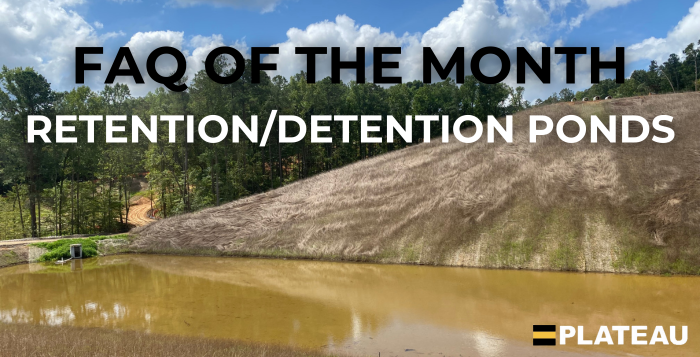Plateau Excavation

FAQ: What is the Difference Between Retention and Detention Ponds?
Retention and detention ponds are two essential components of stormwater management systems. Both play critical roles in controlling runoff and improving water quality, but they serve different purposes and are designed differently. Here’s a breakdown of the key differences between retention and detention ponds.
1. What is a retention pond?
A retention pond, also known as a permanent pond or wet pond, is designed to hold a specific amount of water permanently. These ponds are typically deeper and are meant to retain water, allowing it to slowly infiltrate into the ground or evaporate over time. Retention ponds often provide habitat for wildlife and can improve the aesthetics of an area.
2. What is a detention pond?
A detention pond, often referred to as a dry pond, is designed to temporarily hold stormwater runoff. These ponds do not maintain a permanent water level and typically empty out quickly after a storm event. The primary purpose of detention ponds is to manage peak flow rates and reduce flooding downstream by controlling the release of stormwater.
3. What are the main purposes of retention ponds?
Retention ponds serve several important functions:
- Water Quality Improvement: They help filter pollutants from stormwater, improving water quality before it reaches natural waterways.
- Habitat Creation: Retention ponds can provide habitats for fish, birds, and other wildlife.
- Aesthetic Enhancement: These ponds can enhance the landscape, providing recreational opportunities and improving property values.
4. What are the main purposes of detention ponds?
Detention ponds focus on:
- Flood Control: They manage stormwater runoff to prevent flooding in urban areas by temporarily holding excess water.
- Peak Flow Reduction: By controlling the rate at which water is released, detention ponds help protect downstream channels from erosion and damage.
- Sediment Control: Detention ponds can help settle out sediments from stormwater, improving overall water quality before it discharges into other systems.
5. How do the designs of retention and detention ponds differ?
The designs of retention and detention ponds reflect their different purposes:
- Retention Ponds:
- Designed to hold water year-round, featuring a permanent pool of water.
- Typically deeper, with slopes designed to prevent erosion.
- Include plantings and habitat features to enhance water quality and biodiversity.
- Detention Ponds:
- Designed to hold water temporarily, often dry between storm events.
- Shallower, with gradual slopes to facilitate quick drainage.
- May include a controlled outlet structure to regulate the flow of water leaving the pond.
6. What are the advantages of retention ponds?
Retention ponds offer several advantages, including:
- Continuous Water Storage: Provides habitat and aesthetic value year-round.
- Enhanced Water Quality: Filters pollutants over time, contributing to cleaner water entering natural systems.
- Flood Control: Although less effective than detention ponds in peak flow management, they can help reduce some flooding risk.
7. What are the advantages of detention ponds?
Detention ponds have their own set of advantages:
- Effective Flood Management: Designed specifically to handle stormwater peak flows, reducing the risk of flooding.
- Cost-Effective: Typically less expensive to construct than retention ponds due to their simpler design and shallower depths.
- Reduced Erosion: By controlling the release of stormwater, they help protect downstream water bodies from erosion and sedimentation.